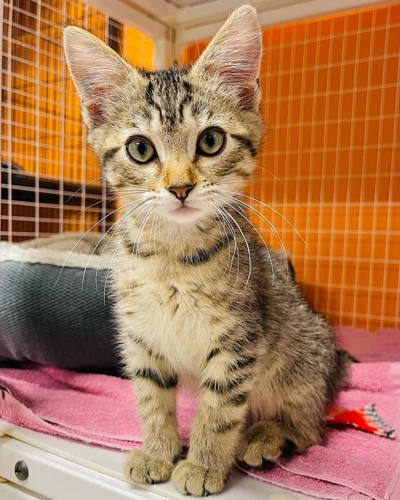Leash training your American Wirehair can seem like a daunting task, especially if you’re a first-time pet owner. Questions like ‘what collar should I use?’ and ‘how do I teach my Wirehair to walk on a loose leash?’ may leave you feeling overwhelmed. However, fear not! With the right mindset and approach, leash training your American Wirehair can actually be a fun and rewarding experience. In this article, we’ll go over some common mistakes to avoid when leash training your Wirehair and provide you with tips for successful training. By the end, you’ll have a better understanding of how to turn your walking experience into something enjoyable for both you and your furry friend.
Mistake #1: Not Using the Right Leash and Collar

One of the first steps in leash training your American Wirehair is selecting the appropriate leash and collar for your pet. This may seem like a simple task, but using the wrong equipment can lead to discomfort, pain, or injury for your furry friend. By not using the right leash and collar, you risk impeding your pet’s progress and making the training process harder for both you and your Wirehair. Let’s explore some tips for selecting and adjusting the right leash and collar in order to make the process smoother and more successful. Don’t miss out on this important aspect of leash training!
Choosing the Right Leash and Collar
Choosing the right leash and collar is essential when it comes to leash training your American Wirehair. There are many types of leashes and collars available in the market. To pick the right one for your cat, consider the weight, size, and temperament of your Wirehair.
Here are some options to choose from:
- A standard leash and collar: This is a good option for cats who are already accustomed to wearing a collar and aren’t easily spooked. Make sure that the collar is adjustable, and that it is not too tight or too loose.
- A harness and leash: This is an excellent choice for cats that are nervous or have a tendency to pull. A harness offers more control without choking your cat. It distributes the pressure evenly across their chest rather than their neck.
- A retractable leash: This type of leash is suitable for cats that have learned to follow commands and walk on a loose leash. Retractable leashes are comfortable to use, but it’s essential to keep them locked when necessary as it can spook your cat and other animals in the surroundings.
In addition to the type of leash and collar, you also need to consider the material and length of the leash. A strong, durable, and comfortable leash that is made of nylon or leather can be an easy pick. Similarly, the length of the leash should be long enough to give your cat some space but not so long that you lose control. The ideal leash length should be around 4-6 feet.
Once you have chosen the right leash and collar, introduce it to your Wirehair slowly. Let them sniff and adjust to it before you attach it. This way, your American Wirehair will be more conducive to healthy training.
For more information on leash training your American Wirehair, check out our article on leash training American Wirehair.
Adjusting the Leash and Collar
To ensure proper leash training, it’s important to adjust the leash and collar properly for your American Wirehair. The right fit not only ensures their comfort but also makes training more effective. Using a leash that is too long or too short may prevent you from controlling your pet, while an ill-fitting collar can lead to discomfort, injury, or even escape.
To make sure that the collar is not too tight, ensure that you can fit two fingers between the collar and your pet’s neck. However, the collar should not be too loose either, or your Wirehair might slip out of it. When adjusting the leash, position it on your pet’s back so that it applies pressure to the shoulders instead of the neck.
It’s important to note that while training, the leash and collar should not be so tight that they are choking your pet. This can cause injury or make your pet fearful of the leash, making training more difficult. Always supervise your American Wirehair while they are on a leash and collar to ensure that they are safe and comfortable.
For more information on leash and collar training, check out our article on Wirehair Kitten Leash Training for tips and strategies on training your American Wirehair. Additionally, consider incorporating clicker training into your routine for a more positive and effective training experience. Finally, remember that teaching your Wirehair to walk on a loose leash will require patience and dedication, but it will be worth it for a well-trained and happy pet.
Mistake #2: Pulling on the Leash

Walking your American Wirehair can be a pleasant and relaxing experience, but it can quickly turn into a frustrating one if your furry friend constantly pulls on the leash. This behavior not only makes it difficult for you to control your Wirehair, but it can also lead to injuries for both of you. Pulling on the leash is a common mistake that many pet owners make, but it’s important to understand why it happens and how to correct it. So, let’s take a closer look at this issue and explore some effective strategies for resolving it.
Teaching Your Wirehair to Walk on a Loose Leash
One common mistake when leash training an American Wirehair is pulling on the leash. To avoid this issue, it’s important to teach your Wirehair to walk on a loose leash. Here are some tips for effective loose leash training:
- Start in a low-distraction environment: Begin training your Wirehair in a quiet and controlled environment, such as your backyard, to help them focus on walking on the leash without getting distracted.
- Use a short leash: A short leash will help you maintain control and prevent your Wirehair from getting too far ahead or lagging behind.
- Stop whenever your Wirehair pulls: If your Wirehair pulls on the leash, immediately stop walking. This will teach them that pulling doesn’t get them where they want to go. Wait until your Wirehair relaxes and the leash slackens before you start walking again.
- Use positive reinforcement: When your Wirehair walks calmly on a loose leash, reward them with treats or praise. This will reinforce the desired behavior and make them more likely to repeat it.
- Be patient: Loose leash training takes time and patience. Don’t get frustrated and always stay calm when your Wirehair pulls. With consistent training, your Wirehair will learn to walk calmly on a loose leash.
Remember, loose leash training is essential for a successful leash training experience with your American Wirehair. By following these tips and staying patient, you’ll be well on your way to teaching your Wirehair to walk calmly and enjoyably on a leash.
Using Positive Reinforcement
Positive reinforcement is a key aspect of successful leash training for American Wirehairs. This method of training involves rewarding your cat for good behavior instead of punishing them for bad behavior. Positive reinforcement not only helps improve your cat’s behavior but also strengthens the bond between you and your pet.
Table: Examples of Positive Reinforcement
| Positive Reinforcement Example | Description |
|---|---|
| Treats | Provide small, healthy treats when your cat follows commands or exhibits good behavior. |
| Praise | Offer verbal praise, such as “good job,” “well done,” or “yes,” when your cat follows commands or walks nicely on the leash. |
| Playtime | Give your cat extra playtime with their favorite toys as a reward for desired behavior. |
| Attention and Affection | Offer your cat extra attention and affection, such as petting, brushing, or cuddling, as a reward for desired behavior. |
Using positive reinforcement also helps your cat associate good behavior with rewards, making them more likely to repeat those behaviors in the future. Additionally, it can reduce stress and anxiety in your cat and promote a more positive training experience.
It’s important to note that positive reinforcement should be used consistently throughout your cat’s training and not just as a one-time reward. This will help reinforce good behavior and discourage unwanted behavior.
Positive reinforcement is a powerful tool for leash training your American Wirehair. By using treats, praise, playtime, and attention, you can encourage your cat’s good behavior and build a stronger bond with your pet. Remember to use positive reinforcement consistently and always stay patient and focused during training sessions.
Mistake #3: Not Being Consistent

Consistency is key when it comes to successful training, yet many American Wirehair owners struggle with maintaining a routine. It can be challenging to find the time and energy to train your furry friend regularly and to enforce the rules consistently. However, failing to be consistent can have a significant impact on your Wirehair’s progress and behavior. Let’s explore why consistency is crucial and how you can overcome this common mistake to ensure successful leash training for your American Wirehair.
Making Time for Regular Training Sessions
Regular training sessions are essential for successful leash training. You should set aside dedicated time each day to work on leash training with your American Wirehair. It may be helpful to create a schedule or routine to follow for consistency. For example, you could aim to have two 10-15 minute training sessions per day, one in the morning and one in the evening.
Here is a table of tips for making time for regular training sessions:
| Tip | Description |
|---|---|
| Make it a priority | Leash training should be a priority for you and your Wirehair, so make sure to set aside time for it each day. |
| Be consistent | Consistency is key when it comes to training sessions. Stick to a routine and try to train at the same time each day. |
| Stay focused | During training sessions, stay focused on your Wirehair and the task at hand. Don’t let distractions pull you away from the training. |
| Keep it positive | Use positive reinforcement during training sessions to keep your Wirehair engaged and motivated. |
| End on a good note | Try to end each session on a positive note, with your Wirehair successfully completing a task or receiving praise or treats. |
By following these tips and making time for regular training sessions, you can help ensure that your American Wirehair successfully learns leash training and develops good walking habits.
Setting and Enforcing Boundaries
Establishing boundaries is an essential part of leash training your American Wirehair. Setting clear boundaries for your pet helps them understand the rules and what is expected of them. Here are some tips for setting and enforcing boundaries during leash training:
- Define your boundaries: Before you start leash training, decide on your boundaries and stick to them. This could include where your pet is allowed to walk, how they are expected to behave, and any areas that are off-limits.
- Be consistent: Consistency is key when it comes to enforcing boundaries. Make sure that everyone in your household is on the same page and that your pet does not receive mixed messages.
- Use positive reinforcement: Encourage your pet to stay within the boundaries you’ve set by using positive reinforcement. Reward them with treats, praise, and affection when they behave well and stay within the designated area.
- Reprimand bad behavior: It’s important to let your pet know when they have crossed the boundary. When your pet misbehaves, use a stern voice to let them know that their behavior is not acceptable, but be careful not to use harsh punishment.
- Monitor progress: Keep an eye on your pet’s behavior during leash training to see how well they are adhering to the boundaries you’ve set. If they are having trouble following your rules, adjust your training approach as needed.
Remember that leash training and boundary setting take time and patience. Be prepared to put in the effort to ensure that your American Wirehair behaves well on the leash and is a well-behaved companion in general. With the right training, your pet will learn to follow your lead and be a joy to walk with.
Mistake #4: Punishing Your Wirehair

When your American Wirehair misbehaves during leash training, it can be tempting to scold or punish them. However, resorting to punishment can actually do more harm than good. While it may seem like a quick fix, punishment can ultimately damage the bond between you and your furry friend and hinder their progress in the training process. So, what can you do instead to encourage positive behavior? Let’s explore some effective alternatives to punishment and learn how positivity can go a long way in training your Wirehair.
Avoiding Physical Punishment
Physical punishment is never an effective training method for American Wirehairs. It not only damages the bond of trust between you and your pet, but it can also lead to aggressive behavior and other serious concerns. Instead of causing physical harm and distress to your Wirehair, you should consider using positive reinforcement techniques.
Here are some alternatives to physical punishment:
| Technique | Description |
|---|---|
| Redirecting | When your Wirehair behaves inappropriately, redirect their attention to a more appropriate activity. For example, if your pet is chewing on something they shouldn’t, replace it with a chew toy |
| Ignoring | If your Wirehair is seeking attention by engaging in unwanted behavior, ignoring them can be an effective teaching method. When your pet stops the behavior, reward them with attention and positive reinforcement. |
| Time-Outs | Time-outs can be an effective way to signal to your Wirehair that their behavior is unacceptable. When executed properly, a time-out can effectively teach your pet to stop unwanted behavior. |
By avoiding physical punishment, you can focus on building a positive relationship with your pet based on trust, respect, and mutual understanding. Positive reinforcement can create a safer and happier environment for both you and your American Wirehair.
Using Positive Reinforcement Instead
When leash training your American Wirehair, it is important to use positive reinforcement to encourage good behavior. Instead of punishing your pet, which can actually lead to increased aggression, try using positive reinforcement techniques to encourage your Wirehair to behave appropriately. Here are some examples of positive reinforcement techniques you can use:
| Technique | Description |
|---|---|
| Clicker Training | This involves using a clicker to make a distinct sound as soon as your pet displays good behavior, followed by a treat. This helps your pet associate the sound with positive behavior. |
| Treat Rewards | Offering treats as rewards for good behavior goes a long way in reinforcing Leash Training. Use small, bite-sized treats, as giving too many treats can lead to weight gain or indigestion. |
| Verbal Praise | Wirehairs respond well to positive feedback and kind words. Keep your tone upbeat and enthusiastic to show them that they are doing well. |
| Playtime Rewards | Playing with your pet is a great way to provide positive reinforcement. You can release them from the leash and allow them some time to play as a reward for good walking behavior. |
Remember, when using positive reinforcement techniques, it’s important to be consistent and provide feedback immediately after displaying good behavior. This will make your pet more likely to repeat that good behavior, leading to a successful leash training experience.
Mistake #5: Not Identifying Behavioral Issues

As much as you may want to blame your American Wirehair for not responding to your leash training efforts, it’s important to look inward and assess whether you’ve properly identified and addressed any underlying behavioral issues that may be hindering their progress. Failure to do so can lead to frustration and a lack of progress in their training. So, how can you ensure that you’re not making the mistake of overlooking your Wirehair’s behavioral issues? Let’s dive in and find out.
Identifying Unwanted Behaviors
One of the most important aspects of successful leash training for your American Wirehair is identifying and correcting unwanted behaviors. By recognizing these behaviors, you can take steps to address them and work towards better leash skills with your pet.
Here are some unwanted behaviors to watch for when leash training your American Wirehair and some strategies for correcting them:
| Unwanted Behavior | Explanation | Correction Strategy |
|---|---|---|
| Pulling on the Leash | Some Wirehairs have a tendency to pull on the leash in an attempt to explore their surroundings or get to a desired location. | Teach your pet to walk on a loose leash using positive reinforcement. Use treats and praise to reward good behavior and stop walking when your pet starts to pull. |
| Barking or Lunging at Other Dogs | Some Wirehairs may become excited or aggressive when encountering other dogs while on leash. | Work with a professional dog trainer or behaviorist to teach your pet to remain calm and focused while encountering other dogs. Use positive reinforcement techniques to reward good behavior and avoid situations that may trigger your pet. |
| Ignoring Commands or Distractions | Some Wirehairs may not respond to commands while on leash or become easily distracted by their surroundings. | Use positive reinforcement to reinforce good behavior and work with your pet in low-distraction environments before gradually increasing the level of distractions. Be consistent with your training and use clear and concise commands. |
By identifying these unwanted behaviors and taking steps to address them, you can set your American Wirehair up for success and enjoy more enjoyable and stress-free walks together. Remember to be patient and consistent with your training, and always use positive reinforcement techniques to encourage good behavior.
Implementing Strategies for Behavioral Change
When identifying unwanted behaviors in your American Wirehair during leash training, it’s important to also implement strategies for behavioral change. Here are some effective strategies to consider:
| Strategy | Description |
|---|---|
| Behavior Replacement | This approach involves finding a desirable behavior to replace the undesirable one. For example, if your Wirehair pulls on the leash, teaching them to walk calmly by your side instead. |
| Desensitization | Desensitizing your Wirehair to certain triggers or stimuli can help reduce unwanted behaviors. For example, if your Wirehair barks at other dogs on walks, gradually exposing them to other dogs while rewarding calm behavior can help eliminate the unwanted barking. |
| Counter-Conditioning | This strategy involves changing your Wirehair’s association with a specific trigger or stimulus. For example, if your Wirehair reacts fearfully to passing cars, you can use positive reinforcement to help them associate the presence of cars with something positive, like treats or praise. |
| Environmental Management | Limiting your Wirehair’s exposure to triggers that cause unwanted behavior can help prevent the behavior from occurring in the first place. For example, if your Wirehair jumps on guests when they enter the house, keeping your Wirehair in a separate room until the guests have settled in can help prevent the jumping behavior. |
It’s important to note that each Wirehair is unique and may respond differently to different strategies. It’s important to observe your Wirehair’s behavior, stay patient, and adjust your approach as needed. With consistent training and positive reinforcement, you can help your American Wirehair become a well-behaved, leash-trained companion.
Tips for Successful Leash Training
Leash training your American Wirehair can be a challenging task, but with the right techniques, it can also be a rewarding experience for both you and your furry companion. To help make the process smoother, we’ve compiled a list of six essential tips for successful leash training. By following these tips and implementing them consistently, you can help your American Wirehair master leash training and enjoy a lifetime of happy walks together.
Starting Small and Building Up
When it comes to leash training your American Wirehair, it’s important to start small and build up gradually. This means not overwhelming your cat with too much too soon. Here are some tips on how to do it:
- Start indoors: Begin by putting your cat on a leash and collar and allowing them to explore indoors. This will help them get comfortable with wearing the equipment before venturing outside.
- Practice in a quiet area: Next, move to a quiet area outside, such as a small backyard or park with limited foot traffic. This will help minimize distractions and allow your cat to focus on the training.
- Gradually increase the duration: Start with short training sessions, just a few minutes at a time, and gradually increase the duration as your cat becomes more comfortable and confident. This will help build up their endurance and allow them to stay focused for longer periods of time.
- Add distractions: Once your cat is comfortable with basic training, gradually add distractions. This could be anything from other people or animals to new sights and sounds. They should learn to focus on you, regardless of the distraction.
- Provide positive reinforcement: Always remember to provide positive reinforcement when your cat behaves the way you want them to. This could be in the form of treats, verbal praise, or affectionate pets.
By starting small and building up gradually, you’ll help your American Wirehair develop the confidence and skills necessary for successful leash training. Remember to always be patient, consistent, and positive in your approach.
Using Treats and Praise to Reinforce Positive Behavior
Positive reinforcement is a powerful training tool when it comes to leash training your American Wirehair. Using treats and praise as rewards for good behavior is an effective way to encourage your pet to continue to walk on the leash in a controlled manner. Here are some tips for using treats and praise to reinforce positive behavior:
- Choose the right treats: Make sure to use small, soft treats that your American Wirehair can eat quickly. You want to avoid treats that are too crunchy or take a long time to chew, as this can distract your pet from the training process.
- Give the treat at the right time: Timing is important when it comes to using treats as positive reinforcement. Give the treat as soon as your pet exhibits the desired behavior, such as walking calmly beside you. This will help your pet associate the treat with the behavior you want them to repeat.
- Use verbal praise: Along with treats, verbal praise is an important part of positive reinforcement. Use a cheerful, enthusiastic tone to let your pet know they are doing a good job. This will help build your pet’s confidence and encourage them to continue exhibiting the desired behavior.
- Be consistent: Consistency is key when it comes to using treats and praise as positive reinforcement. Make sure to give the treat and verbal praise every time your pet exhibits the correct behavior. This will help reinforce the behavior and make it more likely to continue in the future.
- Vary the rewards: While treats and verbal praise are effective rewards, it’s important to switch things up occasionally. This will help prevent your pet from getting bored and keep them engaged in the training process. Consider mixing in a favorite toy or a game of fetch as an occasional reward.
Using treats and praise as positive reinforcement can be a powerful way to reinforce good behavior during leash training. Consistency and a positive attitude are key to success. Remember to choose the right treats, give them at the right time, use verbal praise, be consistent, and vary the rewards to keep your pet engaged and motivated.
Staying Patient and Focused
Patience and focus are key when it comes to leash training your American Wirehair. It can be frustrating at times, but it’s important to remember that your pet is still learning. Here are some tips for staying patient and focused during the training process:
| Tip | Description |
|---|---|
| Take Frequent Breaks | Training for too long without a break can be counterproductive. Your pet can get tired or overwhelmed. Taking frequent breaks can help keep your pet fresh and engaged. |
| Practice Mindfulness | Practice mindfulness by focusing on the present moment during training. Avoid thinking about past failures or future concerns and focus on the progress being made. This can help reduce frustration and increase patience. |
| Set Realistic Expectations | Just like humans, pets have their own personality and learning curve. Don’t expect too much too soon. It’s important to establish realistic goals and work towards them gradually. This helps build confidence for both you and your pet. |
| Celebrate Small Wins | Celebrate every small win along the way. These wins can be as simple as walking a few steps without pulling or responding to a simple command. Positive reinforcement not only gives your pet confidence but also keeps you motivated and patient. |
| Don’t Lose Focus | Stay focused on the end goal of leash training your American Wirehair. Consistency breeds success, so stick to your training routine and methods. Training can be repetitive at times, but reminding yourself of the end goal helps reduce frustration. |
By staying patient, focused, and consistent, you can help your American Wirehair become a well-trained, well-behaved pet on a leash. Remember that every pet is different, so don’t give up even if progress is slow. With perseverance and dedication, you and your pet can enjoy many enjoyable walks together.
Conclusion
In conclusion, leash training your American Wirehair can be a challenging, yet rewarding process. By avoiding common mistakes such as using the wrong leash and collar, pulling on the leash, being inconsistent, punishing your cat, and not identifying behavioral issues, you can ensure success in your training efforts.
Remember to choose the right leash and collar for your Wirehair, making necessary adjustments for a comfortable fit. Train your cat to walk on a loose leash by using positive reinforcement, and be consistent with regular training sessions and setting and enforcing boundaries.
Avoid punishing your cat and instead use positive reinforcement to encourage desired behaviors. It’s also important to identify any unwanted behaviors and implement strategies for behavioral change.
Use tips such as starting small and building up, using treats and praise to reinforce positive behavior, and remaining patient and focused throughout the training process. With these techniques, you can successfully leash train your American Wirehair.
By being a responsible and caring owner, you can create a strong bond with your Wirehair through the training process and enjoy the benefits of a well-behaved cat both inside and outside of the home. Good luck with your training and have fun spending time with your furry friend!
Frequently Asked Questions
1. Can I use any leash and collar for my American Wirehair?
No, it’s important to choose the right leash and collar that is appropriate for your pet’s size and behavior. Consider using a harness if your pet pulls on the leash.
2. How can I teach my Wirehair to stop pulling on the leash?
You can teach your pet to walk on a loose leash by using positive reinforcement techniques like rewarding good behavior and redirecting bad behavior.
3. How often should I train my American Wirehair?
It’s important to make time for regular training sessions and to be consistent in your approach. Aim for a few short training sessions each week.
4. Is it okay to punish my Wirehair for bad behavior?
No, it’s best to avoid physical punishment and instead use positive reinforcement techniques to reinforce good behavior and redirect unwanted behavior.
5. What are some common behavioral issues to watch out for during leash training?
Some common issues include pulling on the leash, jumping, barking, and not responding to commands. Keep an eye out for these behaviors and work on addressing them.
6. How can I change my Wirehair’s unwanted behavior?
You can identify unwanted behaviors by observing your pet during training sessions and implementing strategies like redirection, positive reinforcement, and consistent training.
7. Should I start with short leash training sessions?
Yes, it’s important to start small and build up over time. This allows your Wirehair to get used to the training process and helps ensure success.
8. Can treats and praise be used during leash training?
Yes, using treats and praise can be a great way to reinforce positive behavior and keep your pet motivated during training sessions.
9. Is patience important during leash training?
Yes, patience is key during leash training. It can take time for your pet to learn new behaviors and respond to training sessions, so it’s important to stay patient and focused.
10. What should I do if my Wirehair continues to exhibit unwanted behavior during training?
If your pet continues to exhibit unwanted behavior during training, it may be helpful to consult with a professional trainer or behaviorist. They can offer additional guidance and support for addressing these issues.







